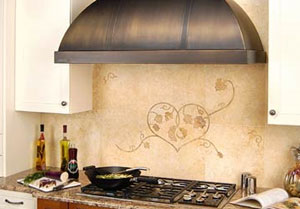Cooking Ventilation System
When it comes to the kitchen of modern homes, the search for the appropriate cooking ventilation system is a serious business and as important as the final choice of cooking equipment. There are three main components of a cooking ventilation system. These essential components must work in complete harmony to achieve optimal ventilation for your kitchen.
The main components of the modern cooking ventilation system are:
- Ventilation Duct
- Blower System
- Hood Canopy
When searching for the right ventilation system for your modern kitchen, it is imperative that you take into account the type of cooking equipment and appliances that are present in your kitchen. This means that you have to make sure that the ventilation duct, the blower system and hood canopy meet the minimum standards or requirements when it comes to heat output of your cooking appliances or equipment. This is usually measured in BTUs, if you are using gas stoves, and watts, if you are using electric cooking appliances or equipment.
Cooking Ventilation System Ducting
It is essential that you don’t scrimp on the size of you ventilation duct. A cooking ventilation system that is powered by a single blower unit would require a 6-inch round duct and an 8-inch round duct for a dual blower unit. If your design involves multiple ducting, then you must remember that the total area covered should reflect the aggregate area of the ventilation ducts.
You must not use corrugated or flexible duct in your cooking ventilation system, as these types of ducts tend to impede the normal flow of air and will ultimately affect the performance of your ventilation system.
Blower Unit of your Kitchen Ventilation System
You must determine the CFM requirement of your cooking ventilation system. For wall-mounted or under-the-cabinet hoods used for standard electric cooking appliance, you would normally require single blower with 300 CFM. On the other, a dual blower with 600 CFM is required for standard professional, gas or electric cooking appliances. Finally, you will have to go for the heavy-duty blower unit with 1200 CFM for large professional ranges and island hoods.
Cooking Ventilation System – Hood Canopy
There are four important variables that you need to take into account to get the right size of the hood canopy. These are the following:
- Holding Capacity – The cooking ventilation system does not suck or pull. This kitchen device only collects the stale air, and we need to take cognizance of the holding capacity that is required to collect the fumes and vapors and expel them through the system’s exhaust. When you have standard cooking appliances in your kitchen, then under-the-cabinet types of hoods are the most appropriate. On the other hand, wall-mounted kitchen hoods are best for commercial cooking settings as well as in kitchens with barbeque grills.
- Mounting Height – The canopy hood must be installed at the recommended height in order to obtain the optimal performance. Verify the standard or recommended mounting height of the specific brand of range hood. Going beyond the specified mounting height for a specific brand can lead to a canopy hood that performs with less efficiency.
- Projection – To ensure that it captures the fumes and vapors, the canopy hood needs to extend out and cover the front edge of your front burners.
- Overlap – If the situation allows it, you must make sure that the canopy hood overlaps your cooking equipment by about 3 inches on both ends, and when it comes to island canopy hoods, this is a must.

